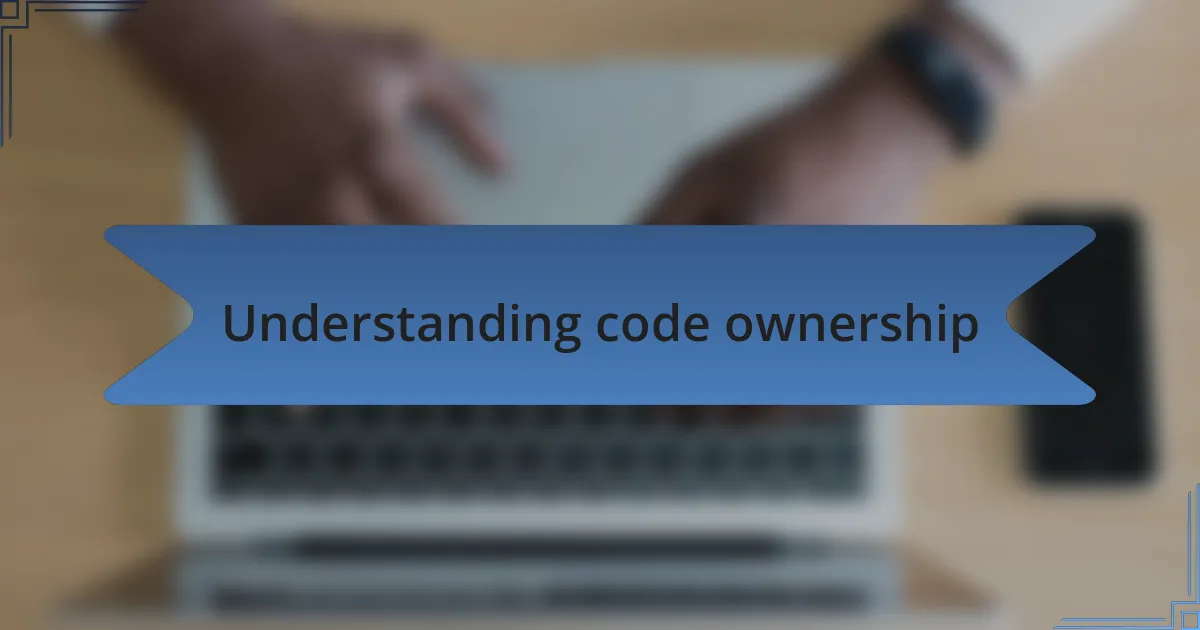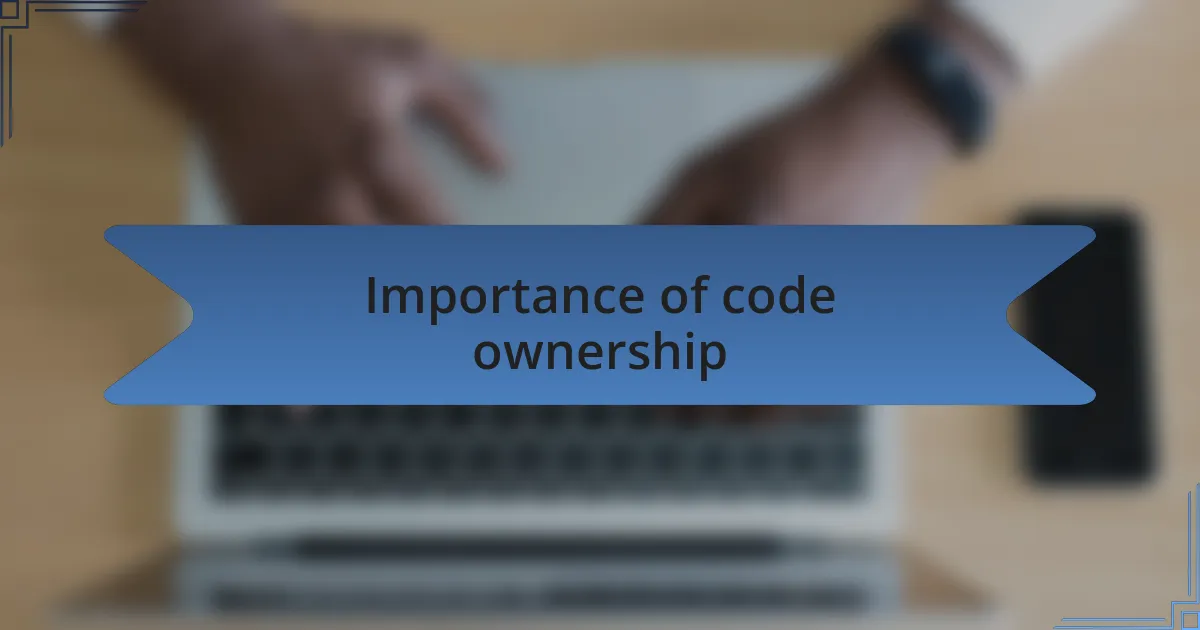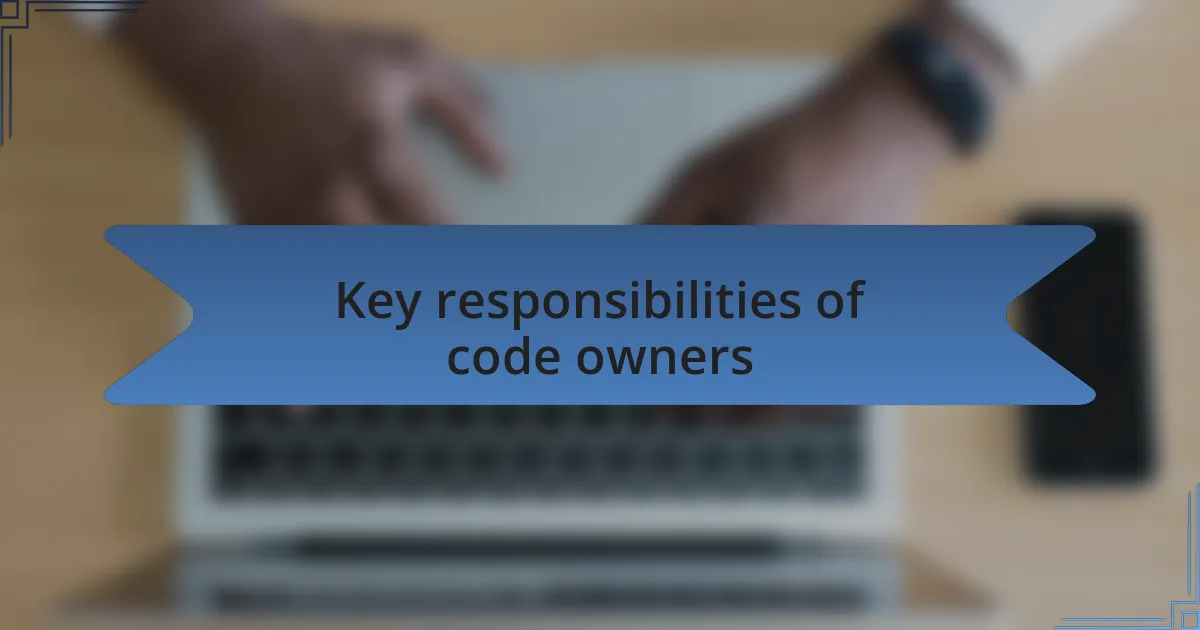Key takeaways:
- Clear code ownership fosters accountability, trust, and motivation, improving team collaboration and project success.
- Effective code owners ensure code quality, provide support to team members, and maintain proper documentation to enhance workflow.
- Challenges include the risk of isolation, balancing maintenance with feature development, and keeping up with evolving technology.
- Communication, setting boundaries, and adopting a growth mindset are crucial for effective code ownership and personal development.

Understanding code ownership
Code ownership is a concept that, to me, transcends just lines of code; it embodies a sense of responsibility and pride in the work we produce. I’ve often found that taking ownership means not just claiming credit but being accountable for the quality and maintainability of the code. Does it surprise you how often projects flounder when no one feels a sense of personal stake in the outcome?
I remember a time when I was part of a team charged with revamping a legacy application. As we delved into the code, it became clear that some components lacked defined owners. The confusion led to overlapping efforts and missed opportunities to streamline our process. It was a stark reminder of how crucial clarity in ownership can be—not just for the productivity of a team, but for the morale of everyone involved.
Have you ever felt that surge of motivation when you know your work has a direct impact on the project’s success? That’s exactly the kind of feeling that comes with solid code ownership. When team members feel empowered and responsible for specific parts of the codebase, it fosters a culture of collaboration and quality. In my experience, this ultimately leads to stronger software and tighter-knit teams—all because individuals understand that they have a vital role in the collective success.

Importance of code ownership
When code ownership is clear, it creates a sense of trust and accountability within the team. I recall a project where I took full responsibility for a critical feature, and the weight of that ownership motivated me to dive deeper, ensuring every detail was polished. Isn’t it fascinating how ownership can drive us to push our limits and elevate our work quality?
I’ve also experienced the frustration that arises when code ownership is nebulous. On one project, I was left in the dark about who owned certain modules, which led to confusion during testing. This chaos not only stressed the team but also delayed our deadlines. It taught me that well-defined ownership serves not just as a structural guide but as a foundation for smoother collaboration.
Moreover, I believe that when team members have clear ownership, they become advocates for their code. I once mentored a junior developer who initially lacked confidence in his contributions. As he took on ownership of a small component and began presenting it to the team, his confidence soared. How rewarding it is to witness someone transform through the encouragement of ownership! It’s a powerful reminder that empowering individuals can lead to collective success and innovation.

Key responsibilities of code owners
One of the primary responsibilities of code owners is to ensure the quality and integrity of their code. I remember a time when I was responsible for an API that was critical for the entire application. Regularly reviewing and refining the code not only enhanced its performance but also instilled a sense of pride in my work. How often do we overlook that maintaining high standards in our own code can ripple through to the whole project?
Additionally, code owners need to act as the first line of support and guidance for their teams. In one instance, a less experienced colleague struggled to navigate through my module. I felt it was crucial to take the time and walk him through it, which not only clarified his doubts but strengthened our collaboration. Have you ever wondered how a small investment of time can pay off in team dynamics and collective knowledge?
Another important aspect is managing the documentation around the code. When I led a project, I made it a habit to update documentation in real time. I found that it saved countless hours during the handoff to other team members. It’s incredible how obstacles can often be avoided with a little foresight and attention to detail, isn’t it?

Challenges faced in code ownership
Code ownership comes with its unique set of challenges, one of which is the potential for isolation. I recall a time when I found myself deeply engrossed in my code, only to realize that I had distanced myself from my team. It felt frustrating not to have them as sounding boards for ideas or feedback. I often wonder, how can we ensure that ownership doesn’t lead to silos but instead fosters collaboration?
Another significant challenge I’ve experienced is the constant balance between time spent on code maintenance and tackling new features. During a particularly hectic sprint, I confronted a bug in my code that required immediate attention. Yet, I felt the pressure of deadlines looming for new developments. It’s a struggle, isn’t it? Striking that balance requires not just time management skills but also a clear prioritization of what’s essential for the project’s success.
Lastly, understanding the evolving technology landscape can be daunting as a code owner. There were moments when I felt overwhelmed by the rapid pace of changes in frameworks and libraries. Keeping my code relevant while still adhering to the best practices I valued was a tough juggling act. How do we adapt without losing sight of the foundation that our work rests upon?

Lessons learned from my experience
One of the most profound lessons I’ve learned is the importance of communication in code ownership. Early on, I assumed that being the sole owner of a piece of code meant I had to handle everything independently. However, as I dove deeper into my projects, I realized that sharing my progress and challenges with my team not only alleviated my isolation but also sparked collaborative solutions. Have you ever felt that lightbulb moment when a simple conversation brings clarity?
I also discovered the value of setting boundaries around my time. There was a period when I would work late into the night, convinced that my dedication equated to better outcomes. In hindsight, I understand that burnt-out developers can lead to subpar code. I now advocate for reasonable work hours, which ensures that creativity flows more freely and sustainably.
Maintaining a growth mindset has been another critical takeaway. I used to shy away from seeking out new technologies, fearing that it would detract from my existing work. However, embracing this learning curve has profoundly impacted my skills and adaptability. How else can we evolve if we don’t challenge ourselves to step beyond our comfort zones?